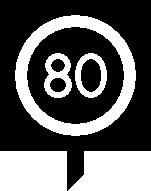|
|
|
|
|
|
|
Where an emergency speed restriction exceeded 2 km (1¼ mile) in length, the Rule Book had required the signalman to verbally advise each driver that approached it until such time as they had been informed of the restriction by special advice or notice. This was intended to avoid a situation where a driver assumes that he or she has missed the termination indicator (see [14.44]) and accelerates while still inside the restriction. To obviate the requirement for the signalman to verbally advise drivers, special signage was used at Standedge Tunnel on occasions when a 20 mph emergency speed restriction had to be imposed throughout its entire length (more than three miles). In addition to the usual signage, a separate sign worded "tunnel" was exhibited underneath the speed indicator [14.72]. Similar signs were available for use at Morley and Bramhope Tunnels from January 2007. The use of these signs at all three tunnels was discontinued in May 2008 when a change to the rules removed the requirement for drivers to be verbally advised of the restriction. |
|
The repeating warning board (see [14.61]) was intended for use only where a distraction (such as a station stop) is located between the warning board and the speed indicator. Although there is no requirement to provide a reminder if the distraction occurs within the temporary speed restriction, i.e. between the speed indicator and the termination indicator, repeater boards have sometimes been provided in that situation. From c.2002, non-standard repeater boards were being provided in some areas for that purpose, comprising a variant of the standard repeating warning board with the two white roundels omitted [14.73 & 14.74].
 |
 |
[14.73] Non-standard Repeater Board.

Area: Various Usage: Medium Status: Uncertain |
[14.74] Non-standard Repeater Board.

Area: Various Usage: Medium Status: Uncertain |
|---|
When a TSR is imposed in an interface area between Network Rail and CTRL infrastructure, speeds will be expressed in both miles per hour and kilometres per hour. The metric speed value is shown in yellow figures on a black background, at both the warning board [14.75] and the speed indicator [14.76]. Differential speeds are not permitted on these signs.
 |
 |
|
[14.75] Warning Board showing imperial and metric speeds.
Area: NR/CTRL Interfaces Usage: Unknown Status: Current |
[14.76] Speed Indicator showing imperial and metric speeds.
Area: NR/CTRL Interfaces Usage: Unknown Status: Current |
|---|
From September 2005, temporary and emergency speed restrictions in the Ashford International area have been indicated by signs showing speeds in both miles per hour and kilometres per hour. The warning boards and speed indicators are of the same design as those that apply to Tyne & Wear Metro units between Pelaw and Sunderland (see [14.70 & 14.71]). At Ashford, however, the "km/h" speed value is always the direct metric equivalent of the miles per hour value (rounded down to the nearest 5 km/h). Where differential speeds apply, two pairs of speed figures are displayed at the warning board [14.77] and the speed indicator [14.78].
 |
 |
|
[14.77] Warning Board for a Differential TSR showing imperial and metric speeds.
Area: Ashford International Usage: Unknown Status: Current |
[14.78] Speed Indicator for a Differential TSR showing imperial and metric speeds.
Area: Ashford International Usage: Unknown Status: Current |
|---|
During high wind conditions, it may be necessary to restrict the speed of electric trains, to prevent damage to the overhead line equipment. In 2006, motorway-style illuminated signs were put on trial at two sites between Morpeth and Berwick on the East Coast Main Line, one near Ulgham Grange level crossing and the other at Belford. Normally these signs were extinguished, but they would be switched on when high winds had been forecast or in the event of high winds occurring that had not been forecast. When the sign was displaying a letter "T" [14.79], no wind-related speed restriction was in force and normal speed applied. When "80" was displayed [14.80], a speed restriction of 80 mph applied to electric trains. Double-headed electric hauled freight trains were, however, restricted to 60 mph. The signs were taken out of use in May 2013, the trial having come to an end.
 |
 |
|
[14.79] Wind Sign displaying "T".
Area: Ulgham Grange / Belford Usage: Low Status: Historical |
[14.80] Wind Sign displaying "80".
Area: Ulgham Grange / Belford Usage: Low Status: Historical |
|---|
During periods of hot weather, it may be necessary to impose emergency speed restrictions as a precaution against the risk of rails expanding to such an extent that they could buckle. The usual signage associated with an emergency speed restriction will be provided. In August and September of 2006, a trial was undertaken on the southern part of the West Coast Main Line to test the effectiveness of signs that will indicate to drivers when a heat speed restriction has not been imposed or has been suspended. During such times, a letter "H" is displayed in place of the restriction speed at both the warning board [14.81] and the speed indicator [14.82]. When "H" boards are displayed, drivers may ignore the signs and drive at normal speed. Although similar in application to a 'spate' indication (see [14.31 & 14.32]), the difference with the "H" boards is that they can be removed and the speed restriction at that location imposed in their place without warning. A further trial was undertaken in August and September of 2008.
 |
 |
|
[14.81] Experimental Warning Board for a Heat Speed Restriction that is not in force.
Area: West Coast South Usage: Unknown Status: Uncertain |
[14.82] Experimental Speed Indicator for a Heat Speed Restriction that is not in force.
Area: West Coast South Usage: Unknown Status: Uncertain |
|---|
A driver that joined a train at a station where a repeating warning board (see [14.61]) was erected may not be aware of a late change having been made to the speed of the TSR beyond. In December 2009, it therefore became practice to exhibit a speed indication at a repeating warning board [14.83], to avoid the risk of overspeeding through the TSR. Where appropriate, a directional indication may also be provided [14.84]. If the TSR is withdrawn early or not imposed, the speed indication may be replaced by a spate indication [14.85].
 |
 |
 |
|
[14.83] Repeating Warning Board.
Area: All Areas Usage: High Status: Historical |
[14.84] Repeating Warning Board with Directional Indication (e.g. applicable to right-hand divergence).
Area: All Areas Usage: High Status: Historical |
[14.85] Repeating Warning Board with Spate Indication.
Area: All Areas Usage: High Status: Historical |
|---|
From December 2013, the presentation was altered to place the repeating warning board above the speed indication [14.86 & 14.87] or spate indication [14.88]. The purpose of this change is to make the "R" visible to drivers before the speed indication when the board is positioned at the end of a station platform.
 |
 |
 |
|
[14.86] Repeating Warning Board.
Area: All Areas Usage: High Status: Current |
[14.87] Repeating Warning Board with Directional Indication (e.g. applicable to left-hand divergence).
Area: All Areas Usage: High Status: Current |
[14.88] Repeating Warning Board with Spate Indication.
Area: All Areas Usage: High Status: Current |
|---|
|
For a trial that began in August 2019, the termination indicators (see [14.44]) for the TSRs on the approaches to certain level crossings and footpath crossings with deficient sighting distances were fitted with an acceleration indicator below. The acceleration indicator was similar in appearance to the termination indicator but displayed a letter "A" [14.89]. The addition of an acceleration indicator to a termination indicator allowed the driver to accelerate when the front of the train reached that point, instead of when the rear of the train passed it. |
|
A trial of digital TSR signs took place in August and September 2024 between Bedford St. Johns and Kempston Hardwick stations. These signs had digital displays that mimicked the appearance of a standard reflectorised warning board (see [14.57]) (miniature type), speed indicator (see [14.42]) and termination indicator (see [14.44]). Once installed, the digital signs can be activated and deactivated remotely at the scheduled times, or the speed displays may be changed, reducing the need for staff to access the track.
|
Acceleration indicators were introduced as standard in December 2024 on the conclusion of trials where they had been fitted below certain termination indicators (see [14.89]). In the standard application, the acceleration indicator is provided by itself [14.90], in place of an ordinary termination indicator showing a letter "T" (see [14.44]). |
|
|
|